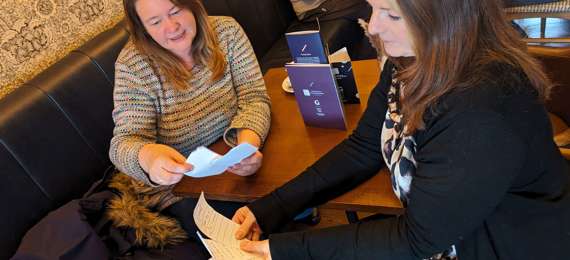
Paper prototypes being tested
Paper prototyping is a simple, quick and cheap way to test a product concept without wasting time and effort on coding or visual design.
As the name implies, this method involves creating a 'prototype' of a product using pieces of paper. When you start out, visuals should be very rough and ready - hand drawn, with the minimum amount of effort. The aim is to get rapid feedback on the overall idea, not to dig into features, functionality or design.
Ideally, paper prototypes should be tested with end users in the actual environment in which they will use the final product. Testing in the real world will very quickly reveal potentially show-stopping issues with your idea, such as difficulty in handling the product and privacy concerns, allowing these issues to be dealt with early on, before they cause a serious problem.
When to use a paper prototype
The first step and most vital step in designing any product is discovery research, in which you explore and de-risk your idea.
This research will allow you to understand your users and your market and create an initial, evidence-based concept for your product. At this point, paper prototyping will allow you to explore that concept with your users to see if it works well enough to justify creating a more complex prototype.
If your idea is flawed, it'll become clear pretty fast. The earlier you find this out, the better - it's far easier to pivot before your product is built than after.
How to create a paper prototype
Once you have developed your product concept, envisage how the finished version might work. Will users typically engage with it on a phone? A tablet? A laptop? Where will they be when they use it - at work? At home? Outdoors?
Don't worry too much about logins or background information - focus on the key functions that you're trying deliver to the user.
Keep it very very simple - ignore elements like branding and button size and placement - these can all be figured out later. Your first effort should be in pencil, with no colour. Essentially it should be ugly and messy, with the bare minimum amount of information to test functionality that is central to the product concept.
Go through your screens in logical order, as if you are using them to complete a task. Can you get all the way through the task quickly and easily? Is something missing? You might need to scrap a screen (literally) and redraw. Don't get bogged down - make something that seems right as quickly as you can and get it tested.
Testing a paper prototype
Once you have created your paper prototype the ideal next step is to test it with real users. Don't be shy about asking your target user to play pretend - most people find it very easy and fun to 'use' a paper phone or tablet and are able to give sensible and useful feedback.
Don't overexplain your prototype. Then ask them to complete whatever task the product is designed for, while speaking out loud about their thinking and their process. This technique - called cognitive walkthrough - will provide a lot of detail on how well the user understands your design. Users will typically comment if something is missing, if they're confused or if something seems to work well.
If your first attempt is a real disaster, you may want to go back and rethink right away. If it seems to work fairly well, it's worth testing with at least four or five users, to get comprehensive feedback before taking your design to the next stage and potentially creating a more complex, click-through prototype.
In a very short amount of time, this testing method allows you to see into the future, to identify potential long-term issues which otherwise might not become apparent until a lot of time and money has been spent on going down the wrong path. As methods go, it's a real no-brainer - it's so easy that there's no reason not to do it.
How Nightingale has used paper prototypes
As part of our joint Innovate UK funded project aimed at revitalising UK high street markets we used paper prototyping to develop and test a basic product concept.
The aim of the project was to develop a tool that could support market managers.
To begin with, our user - a market manager - walked me through a typical day - the tasks, the painpoints, the highs and lows. From this research I carried out a hierarchical task analysis (a fancy way of visualising which jobs come first, second, third, etc).
Using this task analysis I created some paper prototypes of a tool that could support managers to do their job efficiently and accurately. I drew around my phone on a piece of paper, drew screens that seemed to create a logical user journey and cut them out and ordered them so that each 'click' the user made led on to the next screen.
I then took our prototype back out to the market where the manager ran through her tasks, 'clicking' on each 'screen' to see if the flow and content gave her what she needed.
Within two hours we were able to identify what a market manager needs as they go about their regular tasks, which aspects of the prototype were confusing or incomplete and what types of functionality we could add to make the product more attractive and useful.
The next step is to test this prototype with other users who potentially have different needs, to ensure our design has as broad an application (and potential customer base) as possible.



